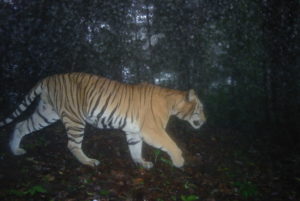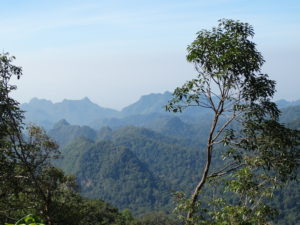Saving the Indonchinese tiger
An extremely long and straight road leading to the sleepy border crossing of Three Pagodas Pass transects Khao Laem National Park in Western Thailand’s Kanchanaburi Province. 305 km from Bangkok, the park was made infamous as one which the World War II Japanese death railway ran though in an attempt to create a supply route for the Japanese Imperial Army to engage the British in Myanmar. This was a long time ago, and much of the railway’s route is now lost underneath a large reservoir build in the 1970’s named after the Kingdom’s young Prince Vajiralongkorn, now Thailand’s new King, Rama the 10th.
The road was built along some of the old rail route and each time I drive to Khao Laem I think about the hundreds of thousands of conscripted slave laborers brought in to build the railway must have suffered in the wet, hot, malarial ridden bamboo forests. These challenges along with the rugged terrain are what have helped keep this very western part of Thailand so sparsely populated, with only one or two small towns dotting the province, inhabited by ethnic groups such as Mon and Karen who fought alongside the British in the war.
Khao Laem is one of 17 protected areas that form the Western Forest Complex, a sprawling 20,000 km wilderness which has its heart the Huai Kha Khaeng-Thing Yai World Heritage Site. Being on the convergence of three bio-geographical zones, this complex has the highest diversity of carnivores anywhere on the planet. From small civets, through Dhole (Asian Wild Dogs), two species of bears, five species of small cats, leopards, clouded leopards, and the Indochinese tiger all call this forest home. With most wildlife surveys confined to the more easily accessible and better known sites, many parks in the Western Forest Complex have had little in the way of ecological research, and there remain large gaps in our understanding of how many wildlife species utilise the landscape.
Although many parks have been around for a long time, Khao Laem was only designated a National Park in 1987, a lack of resources and clear understanding of their importance has led to encroachment and infrastructure projects which have fragmented the habitat and made it difficult for wildlife to disperse to other areas. This has led to human-wildlife conflict in some areas, especially involving Asian Elephants, which regularly raid crops planted by farmers who have invaded the flatter land in the valleys.
As businesses explore opportunities to connect Thailand and China to the Indian Ocean though Myanmar, new roads and railways are being planned as a land bridge to facilitate the transport of shipping containers. This will reduce shipping times by three days as cargo will no longer will need to pass via Singapore. The Chinese belt and road initiative (BRI) will have profound environmental and social impacts as it surgically transects Indochina. So, obtaining an understanding of where wildlife lives is essential to prove how important this habitat is for endangered species such as tigers. Armed with such information, the Department of National Parks, Wildlife, and Plant Conservation will be able to defend important habitats which may hopefully mean roads and railways will be routed through less critical habitat and at the very least wildlife crossings can be integrated into construction plans, such as been successfully implemented in other parts of Thailand.

© DNP/Freeland
Our work in Khao Laem has just started, but we have already documented three large felines in the park. The tigers share their habitat with smaller cats, all these predators remain at risk from poachers who have been photographed during our surveys in exactly the same locations. The hard working park rangers patrol daily with each team patrolling 15 days per month, which in this rugged terrain is extremely arduous. The aims in our project are to learn where the tigers live, start to understand their habits, and plan for a more detailed survey which will give an estimate of how many tigers live per 100 square kilometres, which is a standard comparative measurement. By sharing information with other adjoining parks we are able to compare the tigers photographed of to learn if they are transient, or resident.
We are supporting patrol supplies, technical equipment, and helping review patrol data to see where gaps exist and how these can be plugged to minimise poaching. The park management would like more training for the rangers, both in enforcement tactics and investigations, as we know from a poacher arrested in an adjoining park – affluent hunters even travel from Bangkok to hunt large carnivores. We are looking for further support to help him with this.
For now the race is on, to protect the tigers while proving the importance of this park before the poachers clear out those remaining, which over the last two years have been exterminated in Vietnam, Cambodia, and Lao PDR. We also need to help mitigate any infrastructure which may reduce the tiger’s habitat, or that prevents them from moving around this last wilderness in mainland Southeast Asia. Time is very short for the Indochinese tiger, and so projects such as this which bring together zoos, NGOs, and governments in a concerted effort to save the last tigers are almost their last chance.
Tim Redford, Freeland


